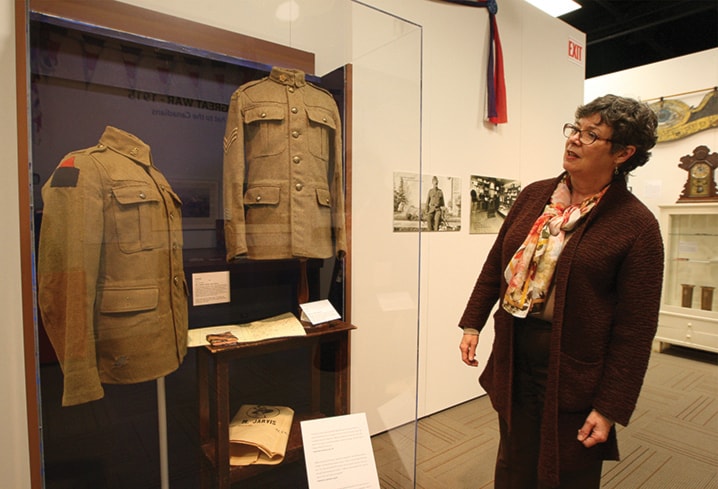They were sent to fight in the muddy trenches of the First World War with rudimentary gas masks and guns that jammed.
But a hundred years ago, Central Albertan soldiers were still “gung-ho” about leaving farm fields behind for hand-to-hand combat in Belgium and France.
“There was a huge fervor to get in the game. Boys were running away to enlist… They wanted to get there before the war was over, so they could be part of the action,” said Lorna Johnson, executive-director of the Red Deer Museum and Art Gallery.
“It was seen as a glorious adventure…”
Yet the grim realities faced by local soldiers in Europe are recounted in Red Deer and the Great War— 1915: The King Will Take His Hat Off to the Canadians. It’s the second of five annual Remembrance Day-themed exhibits mounted at the Red Deer Museum and Art Gallery, marking each year of The Great War.
One of the harshest conflicts of 1915 was the Second Battle of Ypres in Belgium. It featured the first mass use of poison gas by German forces, and resulted in about 100,000 casualties.
Johnson said the battle was significant to Alberta because many local soldiers helped Canada achieve the first victory for a former colonial nation over a European power on European soil.
“The King will take off his hat to the Canadians” is a diary quotation from soldier Cecil B. Whyte, referring to public elation over the important Ypres victory.
Cecil was one of three Whyte brothers fighting in the trenches. While Reginald Whyte returned from the war, moved to Red Deer from Edmonton, and took over the local Ford dealership in 1925, renaming it Whyte Motors, Cecil and Wilfred Whyte, whose sepia photographs are in the exhibit, were killed in France.
Also in 1915, the poem In Flanders Fields was penned by Lieut. Col. John McCrae, a surgeon at the Second Battle of Ypres. While the Ontarian died of an infection in 1918, Johnson said his poem lived on to spark the Royal Canadian Legion’s annual poppy campaign. Early examples of paper poppies are part of the exhibit.
Also displayed is the notorious Ross rifle that Canadian soldiers angrily rioted over. “It was brilliant for target shooting,” noted Johnson, “but in the trenches and the mud, the Ross rifle jammed. It failed as a weapon.”
It was replaced with the more solid and reliable Enfield rifle, which is also exhibited.
Canadian soldiers, unprepared for poison gas attacks, would tell each other to urinate on cloth and breathe through it to get some relief, said Johnson. This low-tech method might have worked as well as some of the equipment they were eventually provided with — including a cloth mask that resembles a flour sack with two glass goggles to see through.
“It’s absolutely primitive,” said Johnson, of the mask on display. Soldiers were expected to tuck the bottom of it into their shirt collars and breathe through a filter that didn’t allow much air to pass through. Johnson said wearers were in danger of suffocating.
Out of about 850 Red Deer people who enlisted in The Great War, 118 soldiers died. This had a devastating effect on regional families — and businesses. Unlike the Second World War which resulted in incoming soldiers training at the Penhold base, the First World War only took people out of the area, including farm labourers. Johnson said the dire affect on Central Alberta’s economy is shown by a long list of Red Deer properties that were auctioned off because the owners were unable to pay property taxes.
“When 25 per cent of the workforce leaves, it has a big impact,” said Johnson.
The exhibit that runs at the museum until Feb. 7 also shows some of the wider societal implications of the war, such as prohibition.
lmichelin@www.reddeeradvocate.com
